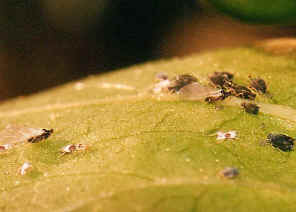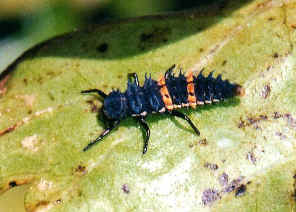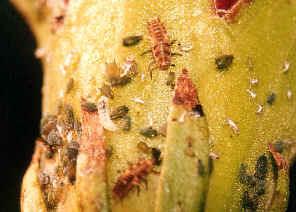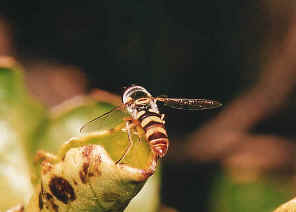|
|
Cowpea Aphid - Aphis craccivora
Family Aphididae
This page contains pictures and information about Cowpea Aphids that we found in the Brisbane area, Queensland, Australia.

- Body length 2mm
This aphid known as Cowpea Aphids or Cow Pea Aphids. Sometimes on the hibiscus plants in our backyard, we can find this aphids. They are grayish-black in colour. They are one of the famous pest, although they seem not doing much harm to our plants.
We have three hibiscus plants in our backyard, the red, pink and yellow. The three plants are close to each others. The aphids only attack the red hibiscus. We can sometimes find one or two aphids on the yellow and pink plants but never see a colony.
The aphids colony expanse very quickly in early spring. Then we can see at last five different predators feeding on the aphids in mid spring. They feed on young shoots and flower buds.


- A new aphids colony is just started on this flower bud. Nymphs pass through four moults. We can see five different size. The white fellows are the newly born aphids. The light-grey ones are the 2nd instars, the dark grey ones are the 3rd instars and the black is the 4th instars. The largest adult just giving bear a new baby. It take about one week for the new born become an adults. From reference books, a female in general produce 100 nymphs in 30 days.
In the crowded colony, sometimes we can find a few winged adults. It is believed that when the colony becomes two crowded, some aphids will became winged and fly to a new location to start a new colony. In the above picture, there are two winged form adults and some other wingless adults. Also notice that there are three empty shells with a hole on each shell. They are the aphid body leave by parasitic wasp.
Wasp - the parasites
In the above first picture, there are three fat yellow-brown aphids, there are parasitised by the wasp. Notice the two on the upper side of the picture, are empty, the wasps had come out already. Near the two dark aphid adults, there is the white shell which is left from a ladybird larvae after moulting.
The above picture are taken at the same flower buds between one week. The first picture showing the flower buds are fully covered with aphids. But over half of the aphids population is yellow-brown in colour and fat, i.e., they are parasitised by the wasp. The second picture, one week later, shows most of the yellow-brown aphids became an empty shell with a small open hole.
Ladybirds - the Predators
We found at least four different ladybird beetles attack the aphids at the same time. Both ladybirds larvae and adults feed on aphids.
The first picture shows Slimline Ladybird larvae. The second picture shows the Slimline Ladybird adult, beside feeding on the aphids, is looking for a place to lay eggs. Usually she will lay a batch of seven or eight eggs, on the bottom side of leaf.
Ladybird larvae feeding on aphids. The above pictures show the Yellow Shouldered Ladybird larvae and adult.
The pictures show the Common Spotted Ladybirds Larvae and adult. We do not see any defence by the aphids against the predation. The aphids seem do not know or do not care about being eaten. They did not even border to run away from the attack. The only defence mechanism that we observed is their growing rate. To reproduce faster than the predation is their way of survival.
The above pictures show some more different ladybird larvae and adult of unknown species.
Hoverfly - the aphids predator
We often see bee-like flies hovering in our hibiscus plants, they are the Hoverfly. Hoverfly larvae are the major predator of the aphids. For a large aphid colony, we can usually find a hoverfly larvae feeding at the middle. The second picture show a Hoverfly adult look for a place to lay eggs.
Lacewings Larvae - the aphids predator
We also saw this Lacewings Larvae hunting the aphids.
Tending by Ants
Aphids excrete honeydew, which is a sweet liquid that is eagerly sought by ants. On the hibiscus plant, the ants are very active at night visiting the aphids colony. The ants come less frequently during the day time. This may indicate that the aphids give more honey-dew at night.
Some ants species are known to provide some kind of protections to aphids. As we observed, the ants species shown did not provide any protection. They just wandering around and look for the honey-dew. They do not care the fly larvae or ladybird larvae eating the aphids.

















